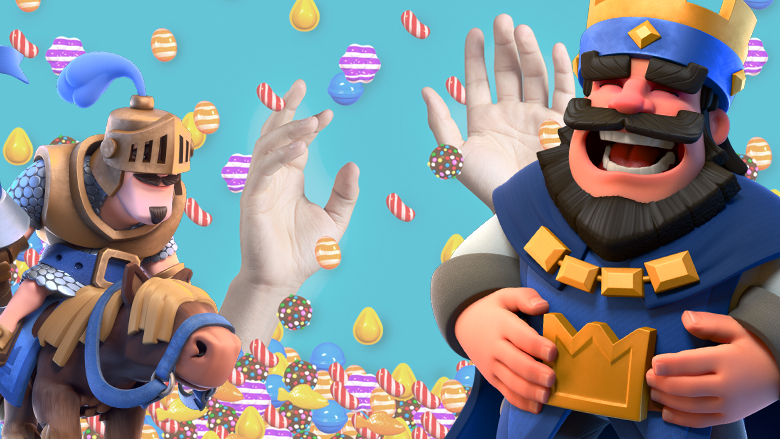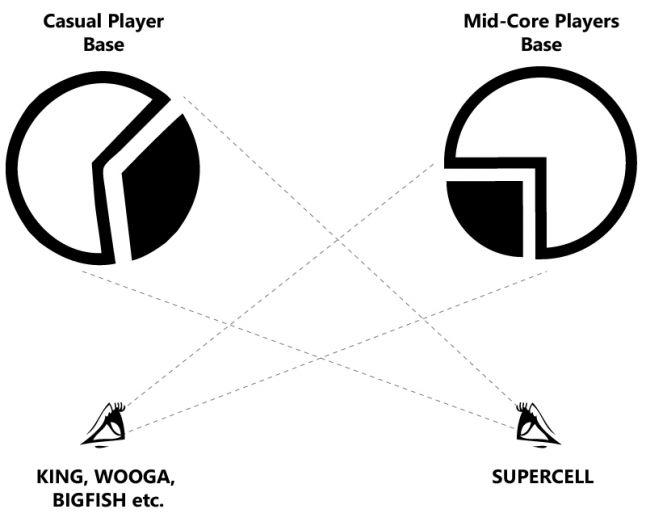A casual midcore — what is it and why is it needed?
The game designer from DIGIT Om Tandon (Om Tandon) in a blog told how he sees the next stage of development of the casual audience. We have translated the text and are sharing it.
In 2012, it was easy to develop a mobile game. It was enough to choose one of three niches — casual, midcore or hardcore. In 2016, this will not work.
You may ask — but why, why are new genre segments needed? Isn’t it possible to stop at these three?
Before continuing, let’s look back and see how changing circumstances, customer habits and market trends have led to the fact that the usual order has been disrupted.
Leading players of the mobile market
There are a lot of strong developers on the mobile gaming market, but if we talk about the leading players, there are only three of them: Machine Zone, Supercell, King.com. Let’s see how they’re doing.
Machine Zone: continues to dominate the market and grow with the release of Mobile Strike, a clone of Game of War in a modern setting. It uses all means for this — from aggressive user purchases to advertising at the Super Bowl.
Supercell: this company with its three top-grossing projects — CoC, BB, Hayday – and constant softlanches confidently sits on the midcore throne. With Clash Royale, the company’s foreseeable future will probably become even brighter.
King.com : released several match-3s, impressive in terms of graphics. I tried to repeat the success of Candy Crush Saga twice — with the game Candy Crush Soda Saga and with Candy Crush Jelly Saga. Activision Blizzard was sold for an impressive $5 billion. At the same time, the company’s revenue continues to fall, and the user base continues to decrease. Obviously, the developer has not yet been able to support the growth of Candy Crush, nor to develop a game to replace it. New games King.com of course, they have some success, but nothing like the flagship title. Although the decline in indicators has not yet acquired the scale of a catastrophe, King cannot fail to understand that it is necessary to constantly come up with something new (and effective) in order to stay in the top. The history of Zynga is an example of this.
The obvious solution for King is to turn to new genres and enter the lucrative midcore games market.
But why midcore and not hardcore? Historically, King has dealt exclusively with casual games. Therefore, it is logical that the company will not dramatically increase the complexity of games, but will follow the path of evolutionary development and move towards midcore. Another reason is that few developers dare to compete with Machine Zone on the hardcore field. Even Kabam, which originally laid the foundation for this genre on mobile platforms, has now lost the palm to Machine Zone and is fully focused on games like Marvel: Contest of Champions, which can be attributed to casual midcore.
Over the past few years , King has repeatedly claimed: “The reason for the consistent decline in the annual indicators of MAU and DAU was the decreased activity of players, mainly in Candy Crush Saga and other “old” games.” There is nothing new here — Zynga has previously encountered the same problem.
But is this really the main problem? And what if we rephrase: “The reason for the consistent decline in the annual indicators of MAU and DAU was the decreased activity of players, mainly in Candy Crush Saga — due to the fact that the user base of casual players has “aged””?
In other words, the audience is not tired of a specific game, but of casual mechanics in general. Then we assume that the decline in indicators is due not to the fact that King games attract users less and less, but to the fact that casual games attract users less and less.
Casual midcore — what is it?
A lot of water has flowed since the first casual matches. Over the past four years, smartphone users who had previously been new to games have grown tired of the same old mechanics. People learn quickly, and therefore they are always looking for new experiences and new tasks with ever-increasing complexity.
Surely you don’t play the same games all the time as you did 4 years ago and don’t watch the same movies? As a player, you have evolved and “aged”.
What made the casual audience “grow old”?
There are several reasons for this — the constantly growing possibilities of choice among game content and genres and the growing skill of users in terms of standard mechanics. Of course, they have been comparing sweets, jellies, cakes and the devil knows what else for more than 4 years!
At the same time, King and other match-3 developers are trying, of course, to entertain the audience by complicating the gameplay, adding boss fights, quests, and so on. But the numbers show that it doesn’t work.
The question naturally arises: even if the audience has “aged”, why not just find new users (the influx of which King, by the way, has also decreased)?
There is one problem with finding new users — the further away, the faster new players “get tired” of casual mechanics. It took the previous generation of users more than 4 years to “get tired” of match-3, but new players go the same way much faster. The thing is that now casual players have a huge choice among projects with interesting mechanics, and therefore the usual match-3 are boring in no time.
So, here’s what’s important: we have a huge number of casual players right in front of our noses, who are just waiting for someone to help them move from one category to another.
A large cluster of veteran players, “tired” of casual mechanics, formed between the traditional segments.
These users are looking for a more complex gameplay, but they are afraid of a high entry threshold, do not like to grind, build bases, train units, manage the economy, do not want to join clans, do not want to strain their brains and plan attacks, which midcore games require. For these players, casual games are already too simple, and midcore games are still too complex.
A genre niche is formed, which requires filling. That’s where Supercell comes on stage with Clash Royale.
Supercell and Clash Royale
Why would Supercell create a game with such a low entry threshold and with mechanics that are very different from the company’s existing projects?
There are two reasons for this:
- like King, Supercell’s user base is “aging”. So why create another midcore toy and take away the audience from existing projects?
- competition in the lucrative midcorn segment is constantly intensifying.
Games like Clash Royale casualize midcore, which means they lower the entry threshold for the “tired” casuals mentioned above.
It turns out that while King and others are looking at the lucrative midcore market, Supercell may have changed the rules of the game and created a genre segment that suits “tired” casual players and in the future may force them to move to the next stage — to midcore.
Who knows, perhaps the gaming industry at the next stage of development will not just collect the existing user base for certain genres, but gradually “grow” it to new genres, lowering the entry thresholds and slowly accustoming the audience to new, more complex mechanics.
Source: Gamasutra



